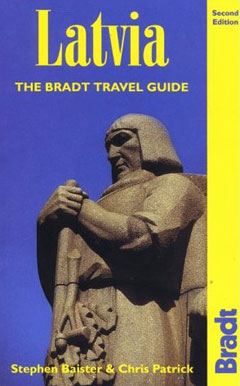
When you pick up the Bradt Travel Guide and give it a peek, some strong points immediately present themselves. Its clear organization and rich, easily accessible information make it a jewel. But like many worthy friends, it has some quirks and tendencies that need to be noted and which are overcome or easily ignored. The two minor flaws are that most scales and values are given in British terms, and a there are a few Latvian spelling and grammar errors. While sparse with photographs, it includes some nice teasers—but this is more a matter of preference of what one really needs in a guide, in my opinion. That being noted, I can now easily bubble on about all of the great advantages this book brings to the reader and traveler.
When touring or visiting, the most prized possession is not the money belt or the destination but a good guide book. The expectations that are created from such books can enhance or detract from the travel’s planning and spontaneity. The normal fare of previewed restaurants and hotels populate the book, yet what makes this book stand out is the rich layer of cultural, historic and artistic information. It gives a succinct overview of Latvia’s complicated history along with fair generalizations about its people. The authors were even able to convey how nature is cherished by Latvians and is part of the nation’s rich culture. This is no mean feat.
Having lived in Rīga for almost two years, a friend and I would challenge each other to see who could find an unknown yet quality restaurant in the Old City. We enjoyed learning about the stories and history of Rīga during these forays. I found even these hard-earned gems were listed in the Bradt guie, giving it a high mark by my reckoning. In the same category as quick reference lists found throughout the guide, there are clear concise maps for trails, road and train.
Besides dedicating a good portion of the book specifically to describing Latvia’s history, economy, people, politics and culture, each of these elements show up again throughout the guide. The authors find highlights for each region’s cities and their surrounding countryside. With this book pointing the way, a visit to some of the smaller towns will provide respites and delightful glimpses of nature. Naturally, some travelers will decide to go more into the country of a region, and each chapter of the guide will have some pertinent story or account to share.
What makes this book better than most is its insights into Latvia’s gnarled, twisting and complex history. It doesn’t try to make that history simple, but it certainly simplifies the learning curve that such a culture deserves.
From small essays that require mulling over, to quick reference lists and maps, this guide has all that a traveler going to Latvia would need. It guides us to a bit of Latvia that only Latvians themselves experience and know. Whether one is just starting to become acquainted with Latvia or already is familiar with the country, this book is well worth its price.
(Editor’s note: This review originally appeared on the SVEIKS.com site.)
Details
Latvia: The Bradt Travel Guide
Stephen Baister and Chris Patrick
London: Bradt Publications, 1999
ISBN 1898323909
© 1995-2024 Latvians Online
Please contact us for editorial queries, or for permission to republish material. Disclaimer: The content of Web sites to which Latvians Online provides links does not necessarily reflect the opinion of Latvians Online, its staff or its sponsors.




